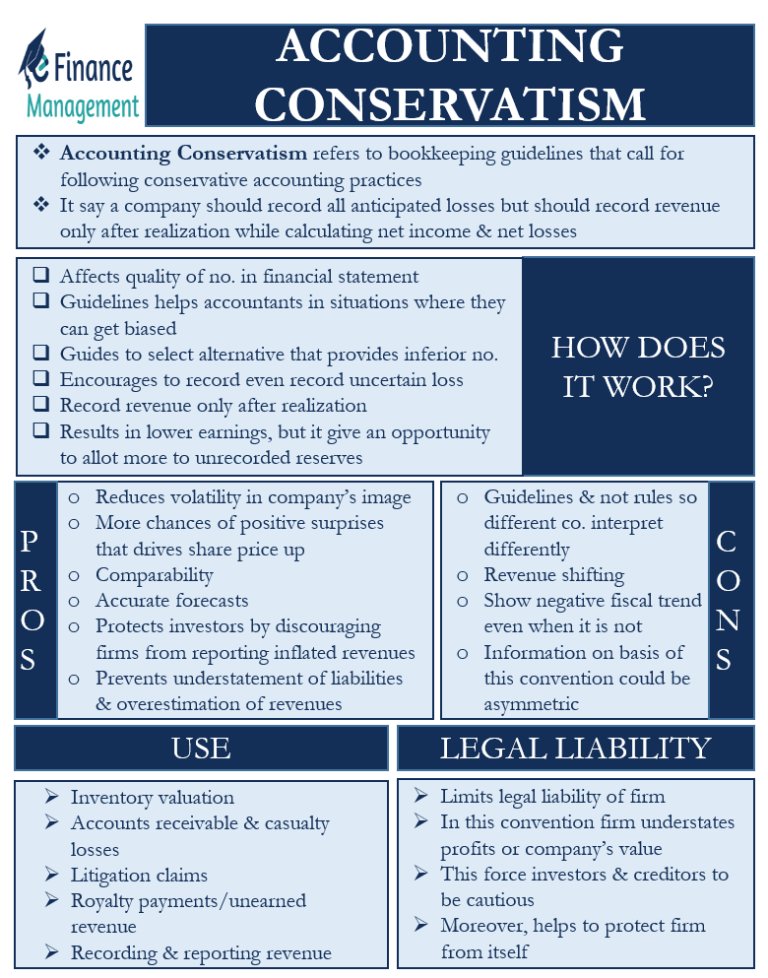
You’ve already listed the lower estimates or worse outcomes, which means there’s good potential for positive gains in comparison. The concept of conservatism encourages a cautious approach to bookkeeping, recording figures only when they are fully verified. Here’s a closer look at how this works, along with the pros and cons of conservatism in financial accounting. A classic example is inventory where the net realizable value (NRV) is less than the actual cost. The accountant must decide whether to leave the inventory at cost or to reduce the inventory amount to its NRV. Conservatism directs the accountant to reduce the inventory to the lower amount (NRV).

Ask a Financial Professional Any Question
Over recognition of revenues and assets, and negligently relay to recognize liabilities are the basic place to start. The Generally Accepted Accounting Principles (GAAP) are a clear set of guidelines. They’re meant to help when it comes to reporting financial information. These accounting standards were put in place to report financial information accurately.
What is conservatism in accounting?
This level of conservatism can put off the recognition of gains for substantial periods of time. There are a number of GAAP rules and guidelines dealing with contingencies and lawsuits, but we will just look at this situation according to the conservatism principle. According to the principle, the company should take the least optimistic approach to the situation, assume they will lose the cases, and adjust the financial statementsaccordingly. The conservatism guideline does not direct the accountant to be super conservative and beat down a company’s profits. This means that accountants should recognize losses and expenses as soon as possible, but delay the recognition of gains and revenues until they are certain. The conservatism principle, also known as the principle of prudence, is an accounting principle that directs accountants and auditors to err on the side of caution when uncertain about the outcome of a transaction or event.
Transparent Reporting
Regardless of how people use your client’s financial information, it’s important to try and not intentionally make the income statement look better than the actual financial position. One rule to help make this happen is called the conservatism principle. At first glance, it seems that the prudence concept requires business entities to record every less favorable situation, but it actually does not. The concept basically urges that financial statements must present a realistic perspective about every possible event that may impact the decision of the users of financial statements.
This results in a lower asset amount and a debit to an income statement account, such as Loss from Reducing Inventory to NRV. In the balance sheet, the “provision for bad and doubtful debts” is reported in the receivables section of current assets and is deducted from the final amount of debtors or receivables. This provision does not show the debtors that have actually become bad. Rather, it shows the debtors that may end up bad based on their trading history with the company or their specific circumstances.
Impact of Conservatism Principle on Financial Statements
- The Conservatism Principle is an accounting principle that suggests accountants should adopt a cautious approach when there are uncertainties or alternative courses of action.
- Finally, it also makes it easier for investors to compare financial results across different industries and time periods.
- Another name used for prudence concept is the conservatism principle of accounting.
- The concept advises that the final accounts of a company must always show caution while reporting any figures, specifically those impacting income and expenses.
Applying the Conservatism Principle, the accountant may choose to be cautious and conservative in estimating the collectibility of these receivables. Instead of assuming that all $10,000 will be collected, the accountant might decide to recognize a potential loss by estimating that only $8,000 will be collected. There are many liabilities that are not certain either in terms of amount or in terms of date, but they have a high possibility of occurrence. In such cases, the liability is recorded, and a corresponding expense is also recognized. This practice makes sure that both liabilities and expenses are not understated. This article has been a guide to the Conservatism Principle of Accounting.
Since the settlement is not certain, GGI does not record the gain on the financial statements. Since a large winning settlement might skew the financial statements and mislead the users, the gain is left off the books. The conservatism principle recognizes that uncertainty is inherent in accounting and that estimates, assumptions, and judgments are often required to prepare financial statements.
This will result in the current period being understated and future periods being overstated, making it difficult for an organization to track business operations internally. One example of conservatism is the accounting rule for reporting inventory on a company’s balance sheet. The accounting rule requires inventory to be reported at the lower of its cost or its net realizable value (NRV).
When estimating allowance for doubtful accounts, casualty losses, or other unknown future events you should always error on the side of conservatism. In other words, you should tend to take the position that is records the most expenses and least income. This is the main principle behind the lower of cost or market concept for recording inventory. Conservatism recording inventory journal entries in your books examples is one of the generally accepted accounting principles (GAAP), which is a set of guidelines drawn up to ensure that companies report financial information in a clear and accurate way. This particular principle requires companies to exercise caution when recording financial activity, opting for solutions that show the least favorable outcome.
